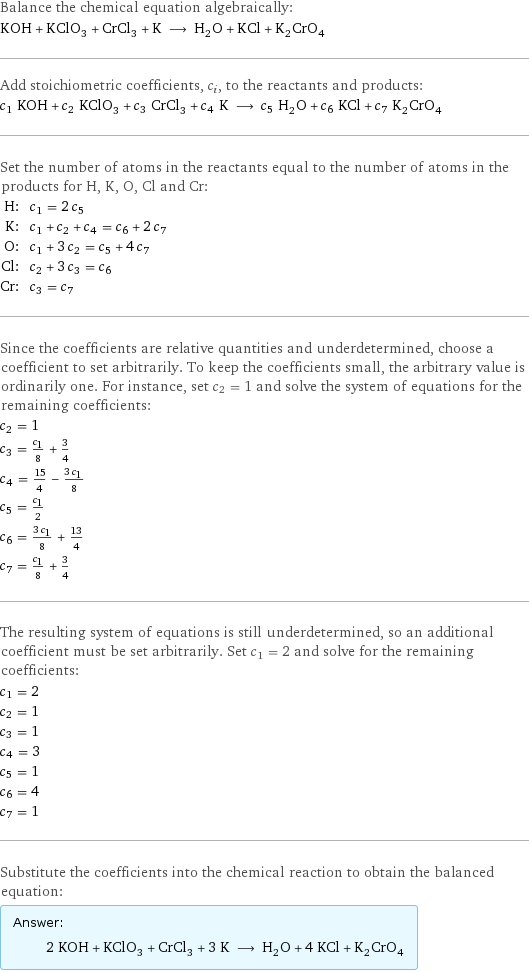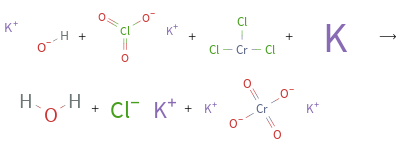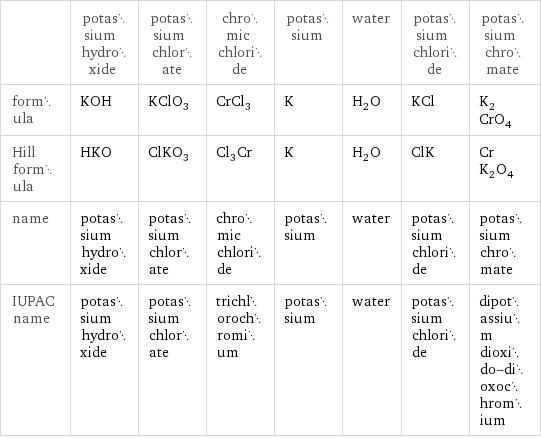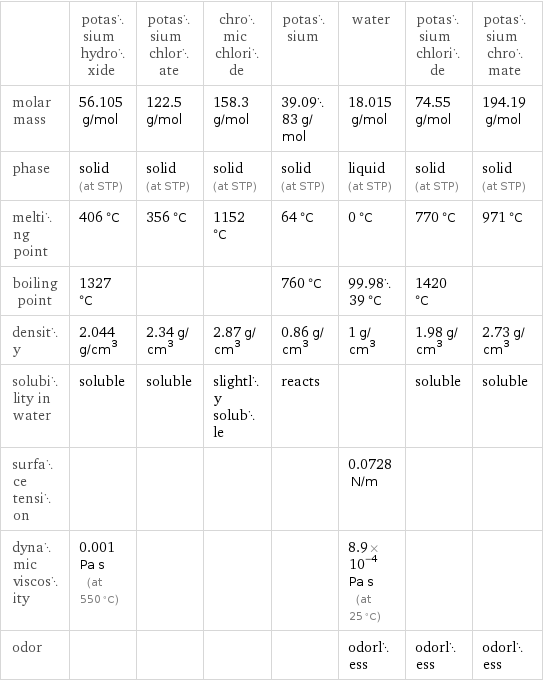Input interpretation

KOH (potassium hydroxide) + KClO_3 (potassium chlorate) + CrCl_3 (chromic chloride) + K (potassium) ⟶ H_2O (water) + KCl (potassium chloride) + K_2CrO_4 (potassium chromate)
Balanced equation

Balance the chemical equation algebraically: KOH + KClO_3 + CrCl_3 + K ⟶ H_2O + KCl + K_2CrO_4 Add stoichiometric coefficients, c_i, to the reactants and products: c_1 KOH + c_2 KClO_3 + c_3 CrCl_3 + c_4 K ⟶ c_5 H_2O + c_6 KCl + c_7 K_2CrO_4 Set the number of atoms in the reactants equal to the number of atoms in the products for H, K, O, Cl and Cr: H: | c_1 = 2 c_5 K: | c_1 + c_2 + c_4 = c_6 + 2 c_7 O: | c_1 + 3 c_2 = c_5 + 4 c_7 Cl: | c_2 + 3 c_3 = c_6 Cr: | c_3 = c_7 Since the coefficients are relative quantities and underdetermined, choose a coefficient to set arbitrarily. To keep the coefficients small, the arbitrary value is ordinarily one. For instance, set c_2 = 1 and solve the system of equations for the remaining coefficients: c_2 = 1 c_3 = c_1/8 + 3/4 c_4 = 15/4 - (3 c_1)/8 c_5 = c_1/2 c_6 = (3 c_1)/8 + 13/4 c_7 = c_1/8 + 3/4 The resulting system of equations is still underdetermined, so an additional coefficient must be set arbitrarily. Set c_1 = 2 and solve for the remaining coefficients: c_1 = 2 c_2 = 1 c_3 = 1 c_4 = 3 c_5 = 1 c_6 = 4 c_7 = 1 Substitute the coefficients into the chemical reaction to obtain the balanced equation: Answer: | | 2 KOH + KClO_3 + CrCl_3 + 3 K ⟶ H_2O + 4 KCl + K_2CrO_4
Structures

+ + + ⟶ + +
Names

potassium hydroxide + potassium chlorate + chromic chloride + potassium ⟶ water + potassium chloride + potassium chromate
Equilibrium constant
![Construct the equilibrium constant, K, expression for: KOH + KClO_3 + CrCl_3 + K ⟶ H_2O + KCl + K_2CrO_4 Plan: • Balance the chemical equation. • Determine the stoichiometric numbers. • Assemble the activity expression for each chemical species. • Use the activity expressions to build the equilibrium constant expression. Write the balanced chemical equation: 2 KOH + KClO_3 + CrCl_3 + 3 K ⟶ H_2O + 4 KCl + K_2CrO_4 Assign stoichiometric numbers, ν_i, using the stoichiometric coefficients, c_i, from the balanced chemical equation in the following manner: ν_i = -c_i for reactants and ν_i = c_i for products: chemical species | c_i | ν_i KOH | 2 | -2 KClO_3 | 1 | -1 CrCl_3 | 1 | -1 K | 3 | -3 H_2O | 1 | 1 KCl | 4 | 4 K_2CrO_4 | 1 | 1 Assemble the activity expressions accounting for the state of matter and ν_i: chemical species | c_i | ν_i | activity expression KOH | 2 | -2 | ([KOH])^(-2) KClO_3 | 1 | -1 | ([KClO3])^(-1) CrCl_3 | 1 | -1 | ([CrCl3])^(-1) K | 3 | -3 | ([K])^(-3) H_2O | 1 | 1 | [H2O] KCl | 4 | 4 | ([KCl])^4 K_2CrO_4 | 1 | 1 | [K2CrO4] The equilibrium constant symbol in the concentration basis is: K_c Mulitply the activity expressions to arrive at the K_c expression: Answer: | | K_c = ([KOH])^(-2) ([KClO3])^(-1) ([CrCl3])^(-1) ([K])^(-3) [H2O] ([KCl])^4 [K2CrO4] = ([H2O] ([KCl])^4 [K2CrO4])/(([KOH])^2 [KClO3] [CrCl3] ([K])^3)](../image_source/1877fe4e416ff83ab1a0ee99f15efecf.png)
Construct the equilibrium constant, K, expression for: KOH + KClO_3 + CrCl_3 + K ⟶ H_2O + KCl + K_2CrO_4 Plan: • Balance the chemical equation. • Determine the stoichiometric numbers. • Assemble the activity expression for each chemical species. • Use the activity expressions to build the equilibrium constant expression. Write the balanced chemical equation: 2 KOH + KClO_3 + CrCl_3 + 3 K ⟶ H_2O + 4 KCl + K_2CrO_4 Assign stoichiometric numbers, ν_i, using the stoichiometric coefficients, c_i, from the balanced chemical equation in the following manner: ν_i = -c_i for reactants and ν_i = c_i for products: chemical species | c_i | ν_i KOH | 2 | -2 KClO_3 | 1 | -1 CrCl_3 | 1 | -1 K | 3 | -3 H_2O | 1 | 1 KCl | 4 | 4 K_2CrO_4 | 1 | 1 Assemble the activity expressions accounting for the state of matter and ν_i: chemical species | c_i | ν_i | activity expression KOH | 2 | -2 | ([KOH])^(-2) KClO_3 | 1 | -1 | ([KClO3])^(-1) CrCl_3 | 1 | -1 | ([CrCl3])^(-1) K | 3 | -3 | ([K])^(-3) H_2O | 1 | 1 | [H2O] KCl | 4 | 4 | ([KCl])^4 K_2CrO_4 | 1 | 1 | [K2CrO4] The equilibrium constant symbol in the concentration basis is: K_c Mulitply the activity expressions to arrive at the K_c expression: Answer: | | K_c = ([KOH])^(-2) ([KClO3])^(-1) ([CrCl3])^(-1) ([K])^(-3) [H2O] ([KCl])^4 [K2CrO4] = ([H2O] ([KCl])^4 [K2CrO4])/(([KOH])^2 [KClO3] [CrCl3] ([K])^3)
Rate of reaction
![Construct the rate of reaction expression for: KOH + KClO_3 + CrCl_3 + K ⟶ H_2O + KCl + K_2CrO_4 Plan: • Balance the chemical equation. • Determine the stoichiometric numbers. • Assemble the rate term for each chemical species. • Write the rate of reaction expression. Write the balanced chemical equation: 2 KOH + KClO_3 + CrCl_3 + 3 K ⟶ H_2O + 4 KCl + K_2CrO_4 Assign stoichiometric numbers, ν_i, using the stoichiometric coefficients, c_i, from the balanced chemical equation in the following manner: ν_i = -c_i for reactants and ν_i = c_i for products: chemical species | c_i | ν_i KOH | 2 | -2 KClO_3 | 1 | -1 CrCl_3 | 1 | -1 K | 3 | -3 H_2O | 1 | 1 KCl | 4 | 4 K_2CrO_4 | 1 | 1 The rate term for each chemical species, B_i, is 1/ν_i(Δ[B_i])/(Δt) where [B_i] is the amount concentration and t is time: chemical species | c_i | ν_i | rate term KOH | 2 | -2 | -1/2 (Δ[KOH])/(Δt) KClO_3 | 1 | -1 | -(Δ[KClO3])/(Δt) CrCl_3 | 1 | -1 | -(Δ[CrCl3])/(Δt) K | 3 | -3 | -1/3 (Δ[K])/(Δt) H_2O | 1 | 1 | (Δ[H2O])/(Δt) KCl | 4 | 4 | 1/4 (Δ[KCl])/(Δt) K_2CrO_4 | 1 | 1 | (Δ[K2CrO4])/(Δt) (for infinitesimal rate of change, replace Δ with d) Set the rate terms equal to each other to arrive at the rate expression: Answer: | | rate = -1/2 (Δ[KOH])/(Δt) = -(Δ[KClO3])/(Δt) = -(Δ[CrCl3])/(Δt) = -1/3 (Δ[K])/(Δt) = (Δ[H2O])/(Δt) = 1/4 (Δ[KCl])/(Δt) = (Δ[K2CrO4])/(Δt) (assuming constant volume and no accumulation of intermediates or side products)](../image_source/b54efab10b55069e37007fee580bef7c.png)
Construct the rate of reaction expression for: KOH + KClO_3 + CrCl_3 + K ⟶ H_2O + KCl + K_2CrO_4 Plan: • Balance the chemical equation. • Determine the stoichiometric numbers. • Assemble the rate term for each chemical species. • Write the rate of reaction expression. Write the balanced chemical equation: 2 KOH + KClO_3 + CrCl_3 + 3 K ⟶ H_2O + 4 KCl + K_2CrO_4 Assign stoichiometric numbers, ν_i, using the stoichiometric coefficients, c_i, from the balanced chemical equation in the following manner: ν_i = -c_i for reactants and ν_i = c_i for products: chemical species | c_i | ν_i KOH | 2 | -2 KClO_3 | 1 | -1 CrCl_3 | 1 | -1 K | 3 | -3 H_2O | 1 | 1 KCl | 4 | 4 K_2CrO_4 | 1 | 1 The rate term for each chemical species, B_i, is 1/ν_i(Δ[B_i])/(Δt) where [B_i] is the amount concentration and t is time: chemical species | c_i | ν_i | rate term KOH | 2 | -2 | -1/2 (Δ[KOH])/(Δt) KClO_3 | 1 | -1 | -(Δ[KClO3])/(Δt) CrCl_3 | 1 | -1 | -(Δ[CrCl3])/(Δt) K | 3 | -3 | -1/3 (Δ[K])/(Δt) H_2O | 1 | 1 | (Δ[H2O])/(Δt) KCl | 4 | 4 | 1/4 (Δ[KCl])/(Δt) K_2CrO_4 | 1 | 1 | (Δ[K2CrO4])/(Δt) (for infinitesimal rate of change, replace Δ with d) Set the rate terms equal to each other to arrive at the rate expression: Answer: | | rate = -1/2 (Δ[KOH])/(Δt) = -(Δ[KClO3])/(Δt) = -(Δ[CrCl3])/(Δt) = -1/3 (Δ[K])/(Δt) = (Δ[H2O])/(Δt) = 1/4 (Δ[KCl])/(Δt) = (Δ[K2CrO4])/(Δt) (assuming constant volume and no accumulation of intermediates or side products)
Chemical names and formulas

| potassium hydroxide | potassium chlorate | chromic chloride | potassium | water | potassium chloride | potassium chromate formula | KOH | KClO_3 | CrCl_3 | K | H_2O | KCl | K_2CrO_4 Hill formula | HKO | ClKO_3 | Cl_3Cr | K | H_2O | ClK | CrK_2O_4 name | potassium hydroxide | potassium chlorate | chromic chloride | potassium | water | potassium chloride | potassium chromate IUPAC name | potassium hydroxide | potassium chlorate | trichlorochromium | potassium | water | potassium chloride | dipotassium dioxido-dioxochromium
Substance properties

| potassium hydroxide | potassium chlorate | chromic chloride | potassium | water | potassium chloride | potassium chromate molar mass | 56.105 g/mol | 122.5 g/mol | 158.3 g/mol | 39.0983 g/mol | 18.015 g/mol | 74.55 g/mol | 194.19 g/mol phase | solid (at STP) | solid (at STP) | solid (at STP) | solid (at STP) | liquid (at STP) | solid (at STP) | solid (at STP) melting point | 406 °C | 356 °C | 1152 °C | 64 °C | 0 °C | 770 °C | 971 °C boiling point | 1327 °C | | | 760 °C | 99.9839 °C | 1420 °C | density | 2.044 g/cm^3 | 2.34 g/cm^3 | 2.87 g/cm^3 | 0.86 g/cm^3 | 1 g/cm^3 | 1.98 g/cm^3 | 2.73 g/cm^3 solubility in water | soluble | soluble | slightly soluble | reacts | | soluble | soluble surface tension | | | | | 0.0728 N/m | | dynamic viscosity | 0.001 Pa s (at 550 °C) | | | | 8.9×10^-4 Pa s (at 25 °C) | | odor | | | | | odorless | odorless | odorless
Units
